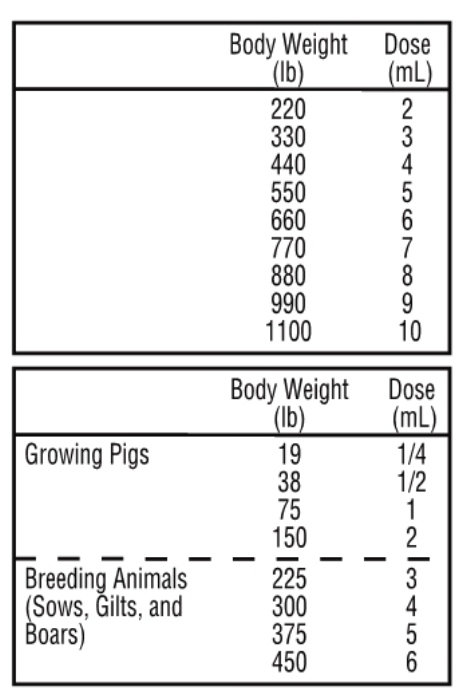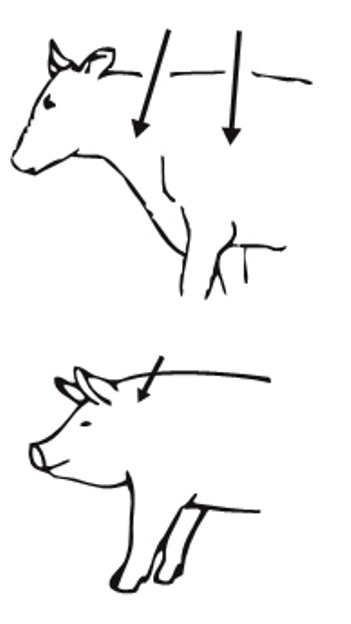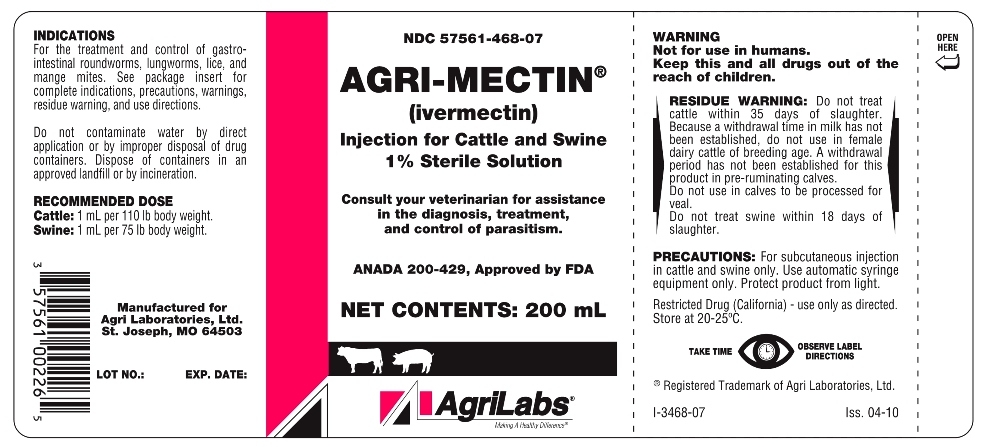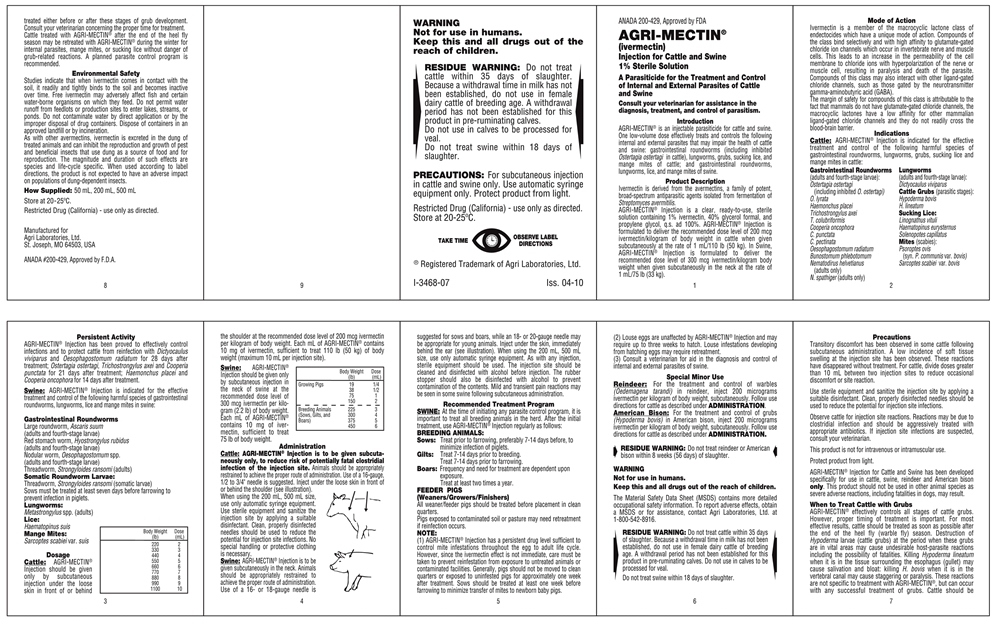AGRI-MECTIN- ivermectin injection
AGRI-MECTIN by
Drug Labeling and Warnings
AGRI-MECTIN by is a Animal medication manufactured, distributed, or labeled by Agri Laboratories, Ltd.. Drug facts, warnings, and ingredients follow.
Drug Details [pdf]
- DESCRIPTION
-
DESCRIPTION
Introduction
AGRI-MECTIN is an injectable parasiticide for cattle and swine. One low-volume dose effectively treats and controls the following internal and external parasites that may impair the health of cattle and swine: gastrointestinal roundworms (including inhibited Ostertagia ostertagi in cattle), lungworms, grubs, sucking lice, and mange mites of cattle; and gastrointestinal roundworms, lungworms, lice, and mange mites in swine.
Product Description
Ivermectin is derived from the avermectins, a family of potent, broad-spectrum antiparasitic agents isolated from fermentation of Streptomyces avermitilis.
AGRI-MECTIN Injection is a clear, ready-to-use, sterile solution containing 1% ivermectin, 40% glycerol formal, and propylene glycol, q.s. ad 100%. AGRI-MECTIN Injection is formulated to deliver the recommended dose level of 200 mcg ivermectin/kilogram of body weight in cattle when given subcutaneously at the rate of 1 mL/110 lb (50 kg). In Swine, AGRI-MECTIN Injection is formulated to deliver the recommended dose level of 300 mcg ivermectin/kilogram body weight when given subcutaneously in the neck at the rate of 1 mL/75 lbs (33 kg).
-
Mode of Action
Ivermectin is a member of the macrocyclic lactone class of endectocides which have a unique mode of action. Compounds of the class bind selectively and with high affinity to glutamate-gated chloride ion channels which occur in invertebrate nerve and muscle cells. This leads to an increase in the permeability of the cell membrane to chloride ions with hyperpolarization of the nerve or muscle cell, resulting in paralysis and death of the parasite. Compounds of this class may also interact with other ligand-gated chloride channels, such as those gated by the neurotransmitter gamma-aminobutyric acid (GABA)
The margin of safety for compounds of this class is attributable to the fact that mammals do not have glutamate-gated chloride channels, the macrocyclic lactones have a low affinity for other mammalian ligand-gated chloride channels and they do not readily cross the blood-brain barrier.
-
Indications
Cattle: AGRI-MECTIN Injection is indicated for the effective treatment and control of the following harmful species of gastrointestinal roundworms, lungworms, grubs, sucking lice and mange mites in cattle:
Gastrointestinal Roundworms
(adults and fourth-stage larvae):
Ostertagia ostertagi
(Including inhibited O. ostertagi)
O. lyrata
Haemonchus placei
Trichostrongylus axei
T. colubriformis
Cooperia oncophora
C. punctata
C. pectinata
Oesophagostomum radiatum
Bunostomum phlebotomum
Nematodirus helvetianus
(adults only)
N. spathiger (adults only)
Lungworms
(adults and fourth-stage larvae):
Dictyocaulus viviparus
Cattle Grubs(parasitic stages):
Hypoderma bovis
H. lineatum
Sucking Lice:
Linognathus vituli
Haematopinus eurysternus
Solenopotes capillatus
Mites (scabies):
Psoroptes ovis
(syn. P. communis var. bovis)
Sarcoptes scabiei var. bovis
Persistent Activity
AGRI-MECTIN Injection has been proved to effectively control infections and to protect cattle from reinfection with Dictyocaulus viviparus and Oesophagostomum radiatum for 28 days after treatment; Ostertagia ostertagi, Trichostrongylus axei and Cooperia punctata for 21 days after treatment; Haemonchus placei and Cooperia oncophora for 14 days after treatment.
Swine: AGRI-MECTIN Injection is indicated for the effective treatment and control of the following harmful species of gastrointestinal roundworms, lungworms, lice and mange mites in swine:
Gastrointestinal roundworms
Large roundworm, Ascaris suum
(adults and fourth-stage larvae)
Red stomach worm, Hyostrongylus rubidus
(adults and fourth-stage larvae)
Nodular worm, Oesophagostomum spp.
(adults and fourth-stage larvae)
Threadworm, Strongyloides ransomi (adults)
Somatic Roundworm Larvae:
Threadworm, Strongyloides ransomi (somatic larvae)
Sows must be treated at least seven days before farrowing to prevent infection in piglets.
Lungworm:
Metastrongylus spp. (adults)
Lice:
Haematopinus suis
Mange Mites:
Sarcoptes scabiei var. suis -
Dosage
Cattle: AGRI-MECTIN should be given only by subcutaneous injection under the loose skin in front of or behind the shoulder at the recommended dose level of 200 mcg ivermectin per kilogram of body weight. Each mL of AGRI-MECTIN contains 10 mg of ivermectin, sufficient to treat 110 lb (50 kg) of body weight (maximum 10 mL per injection site.).

Swine: AGRI-MECTIN should be given only by subcutaneous injection in the neck of swine at the recommended dose level of 300 mcg ivermectin per kilogram (2.2 lb) of body weight. Each mL of AGRI-MECTIN contains 10 mg of ivermectin, sufficient to treat 75 lb of body weight.
-
Administration
Cattle: AGRI-MECTIN Injection is to be given subcutaneously only, to reduce risk of potentially fatal clostridial infection of the injection site.
Animals should be appropriately restrained to achieve the proper route of administration. Use of a 16-gauge, 1/2 to 3/4" needle is suggested. Inject under the loose skin in front of or behind the shoulder (see illustration). When using the 200 mL, 500 mL size, use only automatic syringe equipment. Use sterile equipment and sanitize the injection site by applying a suitable disinfectant. Clean, properly disinfected needles should be used to reduce the potential for injection site infections. No special handling or protective clothing is necessary.
Swine: AGRI-MECTIN Injection is to be given subcutaneously in the neck. Animals should be appropriately restrained to achieve the proper route of administration. Use of a 16- or 18-gauge needle is suggested for sows and boars, while an 18- or 20-gauge needle may be appropriate for young animals. Inject under the skin, immediately behind the ear (see illustration). When using the 200 mL, 500 mL size, use only automatic syringe equipment. As with any injection, sterile equipment should be used. The injection site should be cleaned and disinfected with alcohol before injection. The rubber stopper should also be disinfected with alcohol to prevent contamination of the contents. Mild and transient pain reactions may be seen in some swine following subcutaneous administration.
-
Recommended Treatment Program
SWINE: At the time of initiating any parasite control program, it is important to treat all breeding animals in the herd. After the initial treatment, use AGRI-MECTIN Injection regularly as follows:
Special Minor Use
BREEDING ANIMALS:
Sows: Treat prior to farrowing, preferably 7 - 14 days before, to minimize infection of piglets.
Gilts: Treat 7 - 14 days prior to breeding.
Treat 7 - 14 days prior to farrowing.
Boars: Frequency and need for treatment are dependent upon exposure. Treat at least two times a year.
FEEDER PIGS
(Weaners/Growers/Finishers)
All weaner/feeder pigs should be treated before placement in clean quarters.
Pigs exposed to contaminated soil or pasture may need retreatment if reinfection occurs.
NOTE:
(1) AGRI-MECTIN Injection has a persistent drug level sufficient to control mite infestations throughout the egg to adult life cycle. However, since the ivermectin effect is not immediate, care must be taken to prevent reinfestation from exposure to untreated animals or contaminated facilities. Generally, pigs should not be moved to clean quarters or exposed to uninfested pigs for approximately one week after treatment. Sows should be treated at least one week before farrowing to minimize transfer of mites to newborn baby pigs.
(2) Louse eggs are unaffected by AGRI-MECTIN Injection and may require up to three weeks to hatch. Louse infestations developing from hatching eggs may require retreatment.
(3) Consult a veterinarian for aid in the diagnosis and control of internal and external parasites of swine.
Reindeer: For the treatment and control of warbles (Oedemagena tarandi) in reindeer, inject 200 micrograms ivermectin per kilogram of body weight, subcutaneously. Follow use directions for cattle as described under ADMINISTRATION.
American Bison: For the treatment and control of grubs (Hypoderma bovis) in American bison, inject 200 micrograms ivermectin per kilogram of body weight, subcutaneously. Follow use directions for cattle as described under ADMINISTRATION.
-
WARNINGS
RESIDUE WARNING: Do not treat reindeer or American bison within 8 weeks (56 days) of slaughter.
WARNING
Not for use in humans.
Keep this and all drugs out of the reach of children.
The Material Safety Data Sheet (MSDS) contains more detailed occupational safety information. To report adverse effects, obtain a MSDS or for assistance, contact Agri Laboratories, Ltd. at 1-800-542-8916.
RESIDUE WARNING: Do not treat cattle within 35 days of slaughter. Because a withdrawal time in milk has not been established, do not use in female dairy cattle of breeding age.
A withdrawal period has not been established for this product in pre-ruminating calves. Do not use in calves to be processed for veal.
Do not treat swine within 18 days of slaughter. -
Precautions
Transitory discomfort has been observed in some cattle following subcutaneous administration. A low incidence of soft tissue swelling at the injection site has been observed. These reactions have disappeared without treatment. For cattle, divide doses greater than 10 mL between two injection sites to reduce occasional discomfort or site reaction.
Use sterile equipment and sanitize the injection site by applying a suitable disinfectant. Clean, properly disinfected needles should be used to reduce the potential for injection site infection.
Observe cattle for injection site reactions. Reactions may be due to clostridial infection and should be aggressively treated with appropriate antibiotics. If injection site infections are suspected, consult your veterinarian.
This product is not for intravenous or intramuscular use.
Protect product from light.
AGRI-MECTIN Injection for Cattle and Swine has been developed specifically for use in cattle, swine, reindeer and American bison only. This product should not be used in other animal species as severe adverse reactions, including fatalities in dogs may result.
When to Treat Cattle with Grubs
AGRI-MECTIN effectively controls all stages of cattle grubs. However, proper timing of treatment is important. For most effective results, cattle should be treated as soon as possible after the end of the heel fly (warble fly) season. Destruction of Hypoderma larvae (cattle grubs) at the period when these grubs are in vital areas may cause undesirable host-parasite reactions including the possibility of fatalities. Killing Hypoderma lineatum when it is in the tissue surrounding the esophagus (gullet) may cause salivation and bloat.: Killing H. bovis when it is in the vertebral canal may cause staggering or paralysis. These reactions are not specific to treatment with AGRI-MECTIN, but can occur with any successful treatment of grubs. Cattle should be treated either before or after these stages of grub development. Consult your veterinarian concerning the proper time for treatment. Cattle treated with AGRI-MECTIN after the end of the heel fly season may be retreated with AGRI-MECTIN during the winter for internal parasites, mange mites, or sucking lice without danger of grub-related reactions. A planned parasite control program is recommended. -
Environmental Safety
Studies indicate that when ivermectin comes in contact with the soil, it readily and tightly binds to the soil and becomes inactive over time. Free ivermectin may adversely affect fish and certain water-borne organisms on which they feed. Do not permit water runoff from feedlots or production sites to enter lakes, streams, or ponds. Do not contaminate water by direct application or by the improper disposal of drug containers. Dispose of containers in an approved landfill or by incineration.
As with other avermectins, ivermectin is excreted in the dung of treated animals and can inhibit the reproduction and growth of pest and beneficial insects that use dung as a source of food and for reproduction. The magnitude and duration of such effects are species and lifestyle specific. When used according to label directions, the product is not expected to have an adverse impact on populations of dung-dependent insects. - How Supplied
- STORAGE AND HANDLING
- PRINCIPAL DISPLAY PANEL
-
INGREDIENTS AND APPEARANCE
AGRI-MECTIN
ivermectin injectionProduct Information Product Type OTC ANIMAL DRUG Item Code (Source) NDC: 57561-468 Route of Administration SUBCUTANEOUS Active Ingredient/Active Moiety Ingredient Name Basis of Strength Strength IVERMECTIN (UNII: 8883YP2R6D) (IVERMECTIN - UNII:8883YP2R6D) IVERMECTIN 10 mg in 1 mL Packaging # Item Code Package Description Marketing Start Date Marketing End Date 1 NDC: 57561-468-02 50 mL in 1 VIAL 2 NDC: 57561-468-07 200 mL in 1 VIAL 3 NDC: 57561-468-06 500 mL in 1 VIAL Marketing Information Marketing Category Application Number or Monograph Citation Marketing Start Date Marketing End Date ANADA ANADA200429 12/29/2010 Labeler - Agri Laboratories, Ltd. (155594450)
Trademark Results [AGRI-MECTIN]
Mark Image Registration | Serial | Company Trademark Application Date |
|---|---|
 AGRI-MECTIN 75662008 2610103 Live/Registered |
HUVEPHARMA INC. 1999-03-17 |
© 2025 FDA.report
This site is not affiliated with or endorsed by the FDA.

